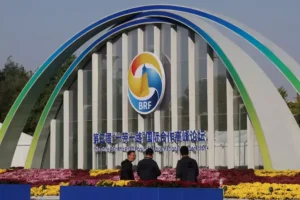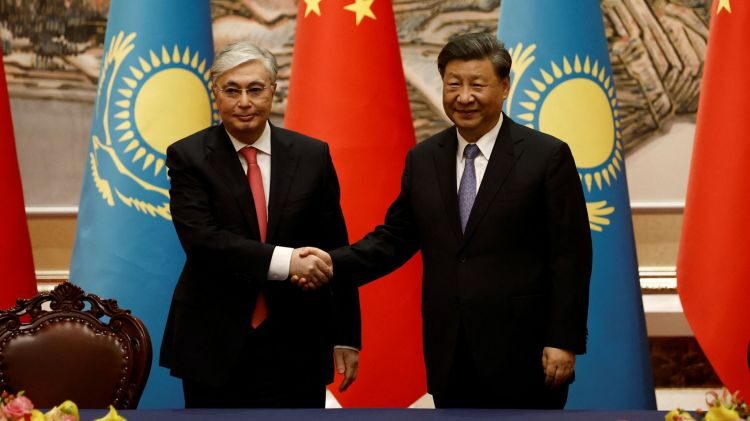
By: Riaz Ahmad Malik
Historically, the Chinese President Xi Jinping announced the Silk Road Economic Belt during his visit to Kazakhstan in 2013. In this way, Kazakhstan became the first country to join the Belt and Road Initiative cooperation 10 years ago.
Undoubtedly, it revolutionized Kazakhstan’s economy, industry, society and changed its economic potential and has further enhanced its trans-regional connectivity and ultimately, it has now drastically changed its geographical status from landlocked to land-linked country. Now more than 153 countries and 30 international organizations have signed more than 230 cooperation agreements with China under the Belt and Road framework, showing the global popularity of the initiative. The BRI has proved Kazakhstan’s effectiveness in finding new means and ways to overcome financial crises, combat pandemics, improve infrastructure connectivity, promote trade and uphold multilateralism.
Comparative studies reveal that from 2013 to 2022, the cumulative two-way investment between China and partner countries reached $380 billion, including $240 billion from China. The value of newly signed construction contracts with partner countries reached US$2 trillion, and the actual turnover of Chinese contractors reached $1.3 trillion. It is due to China’s untiring efforts that the initiative has entered its second decade. During 2022, the leaders of Kazakhstan and China pledged to take bilateral relations into next golden 30 years, which would help the two sides make great achievements and gather rich experience from cooperation.
Obviously, Sino-Kazakh cooperation under the Belt and Road framework plays a special role in bilateral ties. Kazakhstan has become a key link between Eurasia and the Asia-Pacific region thanks to its strategic role as a transport and logistics hub. In this regard, Kazakhstan has successfully aligned its “Bright Road” economic policy with the China-proposed Belt and Road Initiative. Many infrastructure projects built by two countries are already fully functional. They include the China-Kazakhstan International Logistics Base in Lianyungang city, Jiangsu province, the dry port in the Special Economic Zone Horgos-Eastern Gates, the Aktau Port on the eastern coast of the Caspian Sea in Kazakhstan, the China-Kazakhstan-Turkmenistan-Iran transport corridor, and the Western China-Western Europe international transport corridor. These mega projects have further increased its trans-regional connectivity, infrastructure development and national industrialization which are good omen for the New Kazakhstan.
While visiting China, Kazakh President H.E. Kassym-Jomart Tokayev attended the ceremony to begin the construction of Kazakhstan’s logistics center in Xi’an, Shaanxi province, during his state visit to China in May 2023. The logistics center will connect China, Kazakhstan, Central Asia, Europe, Turkiye and Iran. Also, Kazakhstan and China are jointly studying the feasibility of building a third cross-border railway, and have decided to build a container hub at Aktau Port. These projects will help boost Kazakhstan’s trade and unlock the transport potential of the two sides.
The Belt and Road projects have transformed Kazakhstan from a landlocked country to a land-linked country and an important transport hub linking Asia and Europe. Under the Belt and Road framework, Kazakhstan became the first country to establish a production capacity and investment cooperation mechanism with China. According to China’s Ministry of Commerce, Beijing ranked the fifth in foreign direct investment in Kazakhstan in 2021.
The China-Central Asia trade volume reached $70 billion in 2022, with Sino-Kazakh trade accounting for about 45 percent of the total. According to Kazakhstan’s estimates, the trade volume will reach $100 billion in 2030. On its part, Kazakhstan is committed to making efforts to increase Sino-Kazakh trade to $40 billion. By the way, the two sides strive to remove administrative and procedural barriers hindering trade and the flow of capital.
Furthermore, the “Green Silk Road” program initiated by China has promising prospects. In February, Kazakhstan announced that it will achieve carbon neutrality by 2060, and the Green Silk Road can help it realize its important climate goal. China and Kazakhstan are also working on introducing visa-free travel between the two countries, allowing the citizens of the two countries to stay up to 30 days in the other country. It will not only increase bilateral trade but also boost tourism and people-to-people exchanges between the two sides. Coincidentally, 2024 will be the Kazakhstan Year of Tourism in China.
The Belt and Road Initiative has boosted trade and investment across the world, with China sharing its development experiences with other Belt and Road countries.
According to a World Bank report, the initiative helped increase the trade of the Belt and Road countries by 4.1 percent and attracted 5 percent more FDI, while increasing low-income countries’ GDP by 3.4 percent. And by 2030, the initiative is projected to generate $1.6 trillion in annual global revenue, accounting for 1.3 percent of global GDP. More importantly, Belt and Road-related investments are expected to lift 7.6 million people out of extreme poverty and 32 million people out of moderate poverty.
The initiative is set to play a more important role in multinational cooperation despite the rapidly changing global landscape, foundering global recovery, trade restrictions imposed by some economies and the disruptions in global supply chains.
In summary, both countries should cooperate in green energies, EVs, lithium batteries and agriculture. China and Kazakhstan should join hands under the Belt and Road framework to find solutions to regional and international economic and political problems, and restore peace and facilitate development.(The Author is Editor In Chief at The World News AM)


